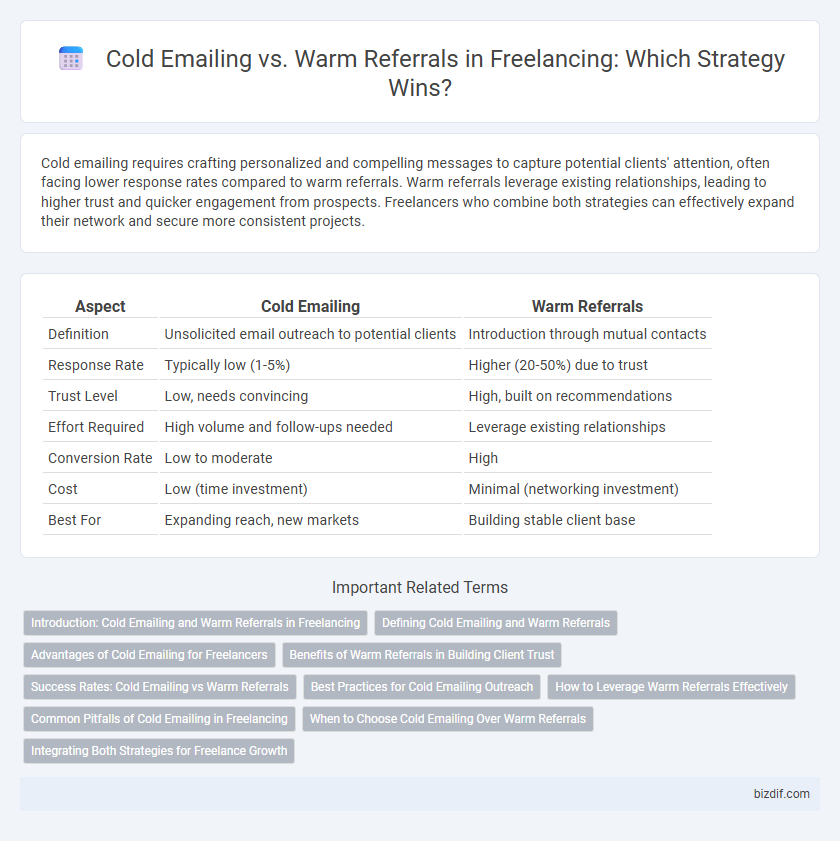Cold emailing requires crafting personalized and compelling messages to capture potential clients' attention, often facing lower response rates compared to warm referrals. Warm referrals leverage existing relationships, leading to higher trust and quicker engagement from prospects. Freelancers who combine both strategies can effectively expand their network and secure more consistent projects.
Table of Comparison
| Aspect | Cold Emailing | Warm Referrals |
|---|---|---|
| Definition | Unsolicited email outreach to potential clients | Introduction through mutual contacts |
| Response Rate | Typically low (1-5%) | Higher (20-50%) due to trust |
| Trust Level | Low, needs convincing | High, built on recommendations |
| Effort Required | High volume and follow-ups needed | Leverage existing relationships |
| Conversion Rate | Low to moderate | High |
| Cost | Low (time investment) | Minimal (networking investment) |
| Best For | Expanding reach, new markets | Building stable client base |
Introduction: Cold Emailing and Warm Referrals in Freelancing
Cold emailing in freelancing involves reaching out to potential clients without prior contact, relying on compelling pitches and targeted messaging to generate interest. Warm referrals leverage existing relationships or mutual connections, often leading to higher trust and increased chances of project acquisition. Data shows that warm referrals can boost client conversion rates by up to 70%, while cold emails typically yield response rates below 20%.
Defining Cold Emailing and Warm Referrals
Cold emailing involves reaching out to potential clients or collaborators without prior contact, relying on well-crafted messages to generate interest and initiate business relationships. Warm referrals occur when existing connections introduce or recommend a freelancer to new prospects, leveraging trust and established rapport to increase conversion rates. While cold emailing casts a wider net with lower initial trust, warm referrals benefit from personalized endorsements and higher credibility.
Advantages of Cold Emailing for Freelancers
Cold emailing enables freelancers to reach a vast and diverse audience beyond their immediate networks, increasing potential client opportunities. This method allows precise targeting using personalized messaging based on client needs and industry-specific pain points, which improves response rates. Furthermore, cold emailing provides measurable results through tracking open and reply rates, enabling freelancers to refine their outreach strategies efficiently.
Benefits of Warm Referrals in Building Client Trust
Warm referrals significantly enhance client trust by providing personalized recommendations from mutual connections, which instantly establish credibility and reduce skepticism. Unlike cold emailing, warm referrals leverage existing relationships, making clients more receptive and likely to engage positively. The trust gained through these referrals often leads to higher conversion rates and long-term professional relationships essential for freelancing success.
Success Rates: Cold Emailing vs Warm Referrals
Warm referrals boast significantly higher success rates in freelancing, with conversion metrics often ranging from 30% to 50%, compared to cold emailing success rates, which typically hover around 1% to 5%. The personalized nature of warm referrals fosters trust and credibility, leading to quicker client engagement and longer-term projects. Cold emailing requires volume and persistence but generally yields lower response rates due to lack of prior relationship and perceived spam.
Best Practices for Cold Emailing Outreach
Effective cold emailing outreach in freelancing requires personalized messages that clearly demonstrate understanding of the recipient's business needs and pain points. Crafting concise subject lines and including a strong call-to-action significantly improve response rates, while maintaining a professional tone builds credibility. Leveraging tools for email sequencing and follow-ups ensures consistent engagement without overwhelming potential clients.
How to Leverage Warm Referrals Effectively
Leveraging warm referrals effectively in freelancing involves building genuine relationships and delivering consistent value to clients who can introduce you to new opportunities. Personalizing your outreach based on the referrer's connection increases trust and response rates compared to generic cold emails. Following up promptly and maintaining professionalism ensures the referral leads to successful long-term collaborations.
Common Pitfalls of Cold Emailing in Freelancing
Cold emailing in freelancing often suffers from low response rates due to generic messages that fail to demonstrate personalized value to potential clients. Many freelancers overlook thorough research on recipients, resulting in irrelevant pitches and diminished credibility. Ignoring follow-up sequences or mismanaging timing further reduces engagement, making cold emailing less effective compared to warm referrals.
When to Choose Cold Emailing Over Warm Referrals
Cold emailing is ideal when entering new markets or targeting niche industries where warm referrals are scarce or nonexistent. It offers scalability and control over outreach frequency, enabling freelancers to test different value propositions and refine messaging based on response rates. Warm referrals excel with trust and higher conversion rates, but cold emailing provides broader access and opportunities during initial client acquisition stages.
Integrating Both Strategies for Freelance Growth
Integrating cold emailing with warm referrals boosts freelance growth by broadening outreach while leveraging trusted connections for credibility. Combining targeted cold emails with referral endorsements increases response rates and client trust, driving steady project acquisition. Utilizing CRM tools to track both approaches maximizes follow-ups and optimizes lead conversion in freelancing.
cold emailing vs warm referrals Infographic

 bizdif.com
bizdif.com